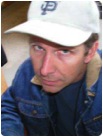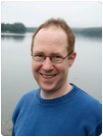 |
|||||||||||||||

A River Lost & Found: The Androscoggin in Time & Place
Michael Kolster and Matthew Klingle
Wednesday, December 11, 2013, 7:00pm
Previously labeled as one of nation’s most polluted rivers, the Androscoggin River has slowly, if incompletely, recovered over time. Yet the river that allegedly inspired the 1972 Clean Water Act remains veiled in stereotype and ignored by the thousands who live along it.
A River Lost and Found explores the hidden past and neglected present of this important New England waterway. Our collaborative project combines photography, oral history, archival research, and non-fiction writing. Here we present a selection of our still-unfolding work. Together we ask how an injured river might reveal an ethic of place that embraces the complexities of human and natural history together. Our answers may suggest how we can embrace places that are neither pristine nor completely despoiled—the very places so many of us call home.
About our Collaboration:
Like many collaborations, ours began with conversations over food and drink about shared interests: fishing, beer, the outdoors, and the importance of place in our lives. It soon evolved into something much more complicated and meaningful.
Independent of one another, we have long explored the connections between place and time in our respective artwork and scholarship. For Mike, his interests as a photographer have taken him across the continent. In the “Changing Places” project, he has visited three exceptional American cities—Las Vegas, San Francisco, and New Orleans—over the past seven-plus years. All three cities are built on unstable ground, threatened by earthquakes or hurricanes or drought. And each of them has a unique subculture, nurtured in response to each city’s volatile location. Likewise, in his first book, Matt explored the environmental history of Seattle, another iconic American city. In his research and writing, he discovered how the century-long interplay between environmental change and social inequality yields new ways to reconsider the interdependence between nature and culture in that most unnatural of places: the city. What unites our divergent work is our shared interest in seeing nature in unexpected places and unexpected ways.
Our project is also an attempt to make sense of our backyard geography. Like so many Americans, we are not from where we live now. Mike spent his formative years in upstate New York before moving to western Massachusetts, Rio de Janeiro, New Haven, and San Francisco before coming to Maine. A native Utahan, Matt had lived in Berkeley, Oakland, and Seattle prior to Brunswick. In the Maine idiom, both of us are “from away,” yet both of us are raising families here. Maine is our home. And in our minds, there is no better way to become native to this place than exploring our nearby river, the Androscoggin.
Through our shared and solo journeys on the Androscoggin, we are learning much about Maine, this river, and how collaborations can yield new ways of seeing the world around us. The opportunity to break out of our typical professional channels—to record oral histories together, make and present multimedia presentations combining images and audio, try our hand at creative writing, to learn new photographic techniques—is a rare gift. The chance to share our discoveries, professional and personal, with diverse audiences across Maine only makes the work that much more rewarding.
Ultimately, we hope that our collaboration, like all partnerships, yields something larger than our own ambitions and efforts. We believe that our project might provide a refreshing, even iconoclastic take on the stale debates over environmental protection and economic progress that afflict Maine and our entire nation. Take the timing of our Bowdoin College Museum of Art exhibition in the summer of 2012, which coincides with the 40th anniversary of the Clean Water Act. Authored by U.S. Senator Edmund S. Muskie, a Rumford native, the Act was supposedly inspired by Muskie’s own local river: the Androscoggin. Yet four decades after this landmark legislation, while dams are coming down on the Penobscot and the stretches of the York might become an official Wild and Scenic River, the Androscoggin remains overlooked and largely unloved. Perhaps in its neglect, however, the Androscoggin might suggest a more complex, humble, and perhaps more sustainable way to consider a new ethic of place suitable for a world facing enormous environmental and social changes.
Our project is an expedition to rediscover the great nearby. To paraphrase the pre-Socratic Greek philosopher Heraclitus, we never step into the same Androscoggin twice. The same is true of any waterway, any landscape. No matter where you live, there is a river or brook near your home, neglected and ignored, or perhaps another waterway long ago, churning your childhood memories. We all have a backyard river and the Androscoggin is now ours.
We invite you to join us on the journey.
Michael Kolster, a 2013 John Simon Guggenheim Memorial Foundation Fellow, teaches at Bowdoin College and lives in Maine with his wife, Christy Shake, and son, Calvin. He is currently producing ambrotypes for a project comparing Maine’s Androscoggin River with other American post-industrial rivers. When not able to shoot outdoors, he works in the studio on a series of still lifes of everyday objects with the wet plate process.
Since July, 2012, he has mounted solo exhibitions at Schroeder Romero & Shredder Gallery in New York City; the Bowdoin College Museum of Art in Maine; Page Bond Gallery in Richmond, VA; 621 Gallery in Tallahassee, FL; the College of Southern Maryland; SRO Gallery at Texas Tech in Lubbock; and Space Gallery in Portland, Maine. Loupe, the Journal of the Photographic Resource Center at Boston University and Memorious published portfolios of his river photographs this year.
An earlier project similarly concerned with land use policy and its implications, entitled Changing Places, depicted changes in Las Vegas, San Francisco and New Orleans over a 10-year time span. In 2009 a 23-image portfolio from Changing Places was acquired for the permanent collection of the George Eastman House International Museum of Photography in Rochester, NY. Work from the same series was featured in Consilience - The Journal of Sustainability, published through Columbia University.
For over ten years Michael has maintained a website, The Daily Post, to which he posts a photograph each day (http://DailyPost.bowdoin.edu).
He was born in Milwaukee, Wisconsin, and has lived in Rochester, New York; Rio de Janeiro, Brazil; Boston, Massachusetts; and San Francisco, California. He holds a BA in American Studies from Williams College, an MFA from the Massachusetts College of Art, and a certificate from the full-time Documentary Photography program at the International Center of Photography in New York City.
Matthew Klingle, a fourth-generation Westerner, was born and raised in Salt Lake City, Utah. A historian of the United States, his research and teaching focus on the North American West, environmental history, urban history, social and cultural history, and the history of science, technology, and medicine. He has received fellowships and awards for his work from the Andrew W. Mellon Foundation, American Council of Learned Societies, National Endowment for the Humanities, U.S. Environmental Protection Agency, National Science Foundation, Organization of American Historians, American Society for Environmental History, Urban History Association, and Western History Association. He also held a national fellowship in 2002-04 from the Environmental Leadership Program, a nationwide organization training emerging leaders from wide-ranging social and professional backgrounds to promote greater diversity in the environmental movement, and later served on the ELP board of directors. In 2006 he received the Sydney B. Karofsky Prize for Junior Faculty, the only award for teaching at Bowdoin College.
Watercolors by
Sarah Stapler
Sarah Stapler


